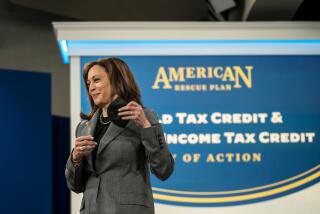And the Debt Gets Bigger
- Share via
Democratic leaders in the House tried to foil President Bush’s capital gains tax cut with a plan for reinstituting individual retirement accounts and raising the top income rate on the wealthy from 28% to 33%. The plan actually made more economic and fiscal sense than Bush’s gains cut. It at least would have paid for itself, provided some extra money for deficit reduction, encouraged savings and helped more middle-income Americans rather than the most affluent. But Republicans again raised the old specter of Democrats as taxers and spenders and held out the dubious supply-side lure of getting something for nothing through a lower capital gains tax. The outcome was no contest: The Democrats’ plan lost 239-190.
The Bush proposal now has a political momentum that will be difficult to stop in the Senate. The House got bullied into a gimmick that in the long run will only add to the budget deficit and have at most a negligible effect on the economy. The present proposal for a two-year reduction of the capital gains levy to 19.6% would raise some cash in the short term merely by triggering a rush to sell assets now, followed by a cap of 28% and the indexing of capital gains for inflation. If the Senate cannot kill the plan, which it probably cannot, it at least should give it some fiscal responsibility by raising other revenues to offset the losses created by the indexing feature after 1992--more than $10 billion in fiscal years 1993 and 1994.
Proponents argue, of course, that the losses will be made up by the increased income taxes reaped from the new investment triggered by the capital gains benefits. But most economists discount such estimates. Almost half of all new venture capital comes from pension funds that do not pay taxes. Corporations, foundations and foreign investors account for another third. They are not affected because the proposed cut would be granted only to individuals, who are putting up less than 10% of new capital.
The original 1984 Treasury Department tax reform plan argued for taxing capital gains as ordinary income or indexing it, but not both. The old preferential rate was designed to be anoffset to inflation, Treasury explained. Treasury argued against a lower capital gains rate because it encouraged investments offering asset appreciation at the expense of those that promised more current income in the form of interest or dividends.
An estimated 80% of the benefits from the capital gains cut now on the verge of passing the House would go to taxpayers earning $100,000 or more. That element of inequity might be tolerable if the tax cut plan had some other compelling economic logic to it. But it does not. Even worse, it would aggravate the major fiscal and economic problem facing the country--a staggering budget deficit that keeps getting bigger.
More to Read
Get the L.A. Times Politics newsletter
Deeply reported insights into legislation, politics and policy from Sacramento, Washington and beyond. In your inbox twice per week.
You may occasionally receive promotional content from the Los Angeles Times.










